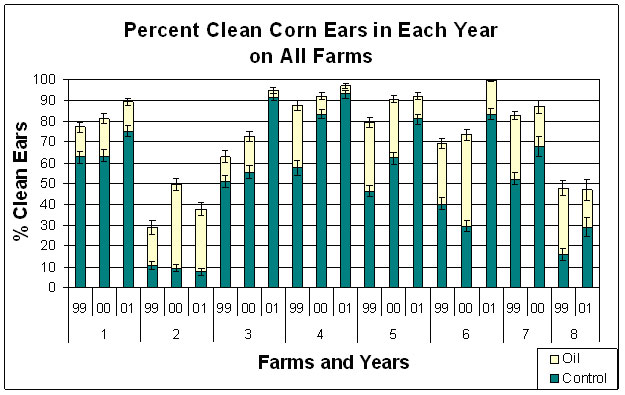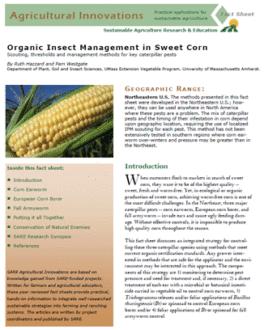With funding from SARE and from the Organic Farming Research Foundation (Santa Cruz, CA) the organic caterpillar control methods outlined in this article were tested on eight commercial vegetable farms throughout New England from 1999 to 2001. During the project, grower interest and input guided the development of the Zea-laterTM applicator device and further studies on the timing and longevity of the oil treatments. Of the eight farms that participated in the project, six continue to grow sweet corn; all of these farms have continued to use the control methods outlined above.
For three growing seasons (1999-2001), three blocks of corn per year were planted on each farm to test the effectiveness of the Bt foliar sprays for European corn borer (ECB) and fall armyworm (FAW), combined with oil treatments to the silks for corn earworm control (CEW)). All of the ears in one half of each planting were oiled for CEW control while the other half was not, regardless of the pest pressure. When foliar applications were applied, all corn in the planting was treated. All corn plantings were scouted for ECB and FAW damage and traps were monitored for ECB, FAW and CEW pressure. At harvest, 100 oiled corn ears and 100 non-oiled ears were scored for damage and caterpillars. Any caterpillar damage to the kernels, however slight, rendered the ear non-marketable for the purposes of this study.
All farms showed significant improvement in the quality of the ears between the oiled and the non-oiled ears of corn. Four out of the eight farms were able to achieve a three-year average of over 80% clean ears with the oil method (Table 2), with improvements each year of the project (Figure 1). A significant portion of damage on some of the farms was due to poor control of the ECB pest with the foliar spray due to poor timing, too few sprays, or lack of spray when called for [11]. Other farms, such as Farm # 2, struggled with very high CEW pressure and poor weed control (Table 2). See the full report for more detailed results and individual farm profiles.
The timing of the oil/Bt application can be critical to the success of this method and the development of the corn ears. In one timing experiment conducted over two growing seasons, different plots received one oil application on day 3 to 11 after 50% of the field showed first silk. The percent cone tip at harvest decreased linearly with the day of treatment application in both years. The best combination of effective insect control resulting in the highest rates of marketable ears with the least degree of cone tip was achieved by application on days 5 to 7 after 50% of the field showed silk. This window is likely to vary by a day or two depending upon the temperature.

In another timing experiment, we examined the effectiveness of the oil treatment relative to when the CEW larvae entered the silk channel. In two seasons, oil, Bt or oil+Bt was applied on day 5 after 50% silk. Newly hatched CEW larvae were then applied to those oiled ears and to non-oiled ears on day 3, 6, 9, 12, 15, or 18. Ears were picked and examined four days after each larvae application. Both oil and Bt-treated ears had fewer larvae and less feeding damage than the non-treated ears. Oil and Bt, alone or together, provided protection to the ears up through the end of the experiment at 22 days after 50% silk. When the larvae were applied to the silk two days before the oil treatment, damage was not significantly less in treated ears compared to untreated ears.
| Farm | Location | Total Veg. Acres | Acres of Sweet Corn | Markets | 3 Years; Average Flight/Night | % Clean Ears All 3 Years | ||
| ECB | CEW | No Oil | Oil Treated | |||||
| 1 | Maine | 36 | 2 | Wholesale | 1.6 | 4.9 | 67.1 | 82.7 |
| 2 | Rhode Island | 16 | 2.5 | Wholesale Farmstand CSA | 4.7 | 11.7 | 9.1 | 388 |
| 3 | Southern VT CT River Valley | 50 | 12 | Wholesale Farmstand | 12.3 | 1.0 | 65.8 | 76.7 |
| 4 | Southern VT CT River Valley | 30 | 10 | Farmstand | 4.7 | 1.3 | 77.8 | 92.2 |
| 5 | Western MA CT River Valley | 18 | 4 | CSA | 2.7 | 2.3 | 63.0 | 87.0 |
| 6 | Central MA | 30 | 6 | Farmstand | 4.4 | 9.0 | 50.1 | 73.4 |
| 7 | Western MA CT River Valley | 38 | 4.5 | Wholesale | 5.7 | 0.4 | 60.2 | 84.9 |
| 8 | Central CT CT River Valley | 22 | 1 | Farmstand Farmer's Markets | 1.4 | 1.2 | 22.5 | 47.5 |
